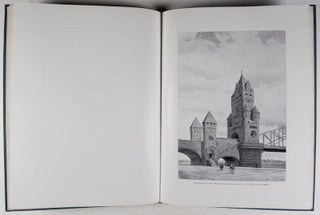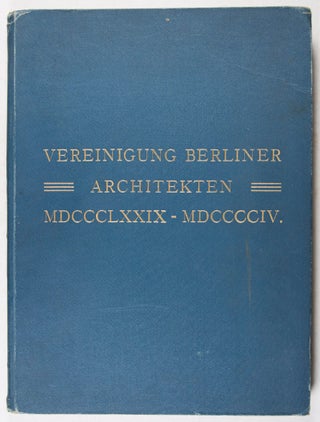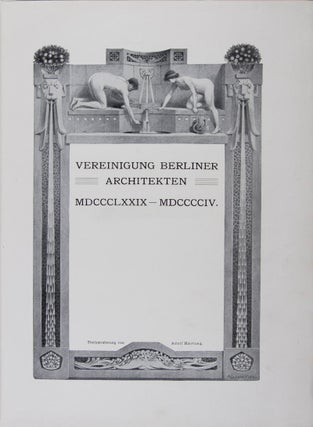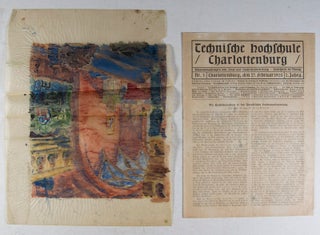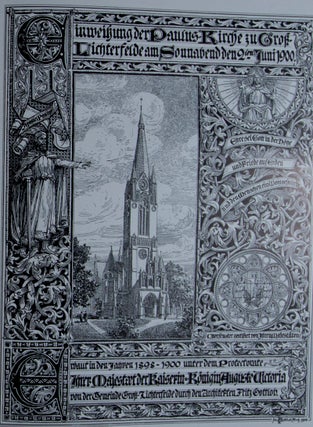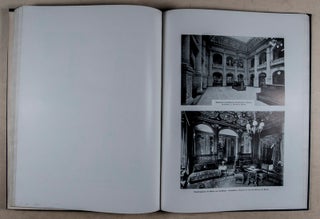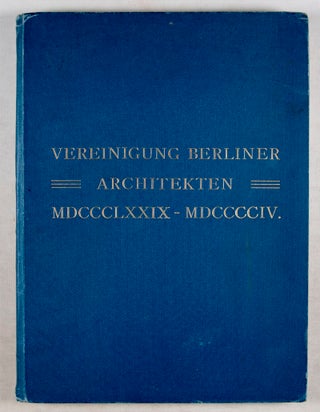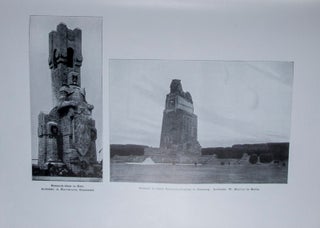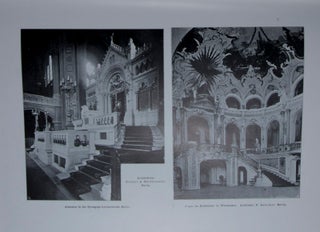Vereinigung Berliner Architekten MDCCCLXXIX-MDCCCCIV
[Berlin]: Vereinigung Berliner Architekten, [1905]. First edition. Hardcover. Folio (13 1/2 x 10 1/4"). 58, [2]pp (Text and in-text illustrations), [56] leaves (Plates). Original blue cloth, with gold lettering to front cover. Decorative endpapers. Laid in, an original and unsigned watercolor on transparent paper, and the third issue of the Technische Hochschule Charlottenburg, dated February 27, 1920. Title page decorated by Adolf Hartung.
This splendid photo-illustrated architectural monograph was published by the Union of Berlin Architects (Vereinigung Berliner Architekten) to commemorate the 25th anniversary of their founding.
The founding members included distinguished historians as well as Martin Gropius, a celebrated architect and the uncle of Walter Gropius. By 1904, the association had over two hundred members. As seen in this book, the Union was an active participant in the architectural life of Berlin and curious about developments elsewhere.
"Vereinigung Berliner Architekten MDCCCLXXIX-MDCCCCIV" features striking full-page b/w illustrated and photographic plates showing some of the best architectural examples produced between 1879 and 1904, such as:
- The Berlin Dom (Cathedral), constructed from 1893 to 1905 by Julius Carl Raschdorff.
- An architectural drawing of the Metz railway station, under construction at the time of the publication. The impressive Gothic-style station was built between 1905 and 1908 by German architect Jürgen Kröger assisted by the architects Jürgensen and Bachmann.
- The Kaiserbrücke, a railway bridge on the Mainz rail bypass across the Rhine at the north end of Mainz. The bridge was built between 1901 and 1904 by Franz Heinrich Schwechten, one of the most famous architects of his time who contributed to the development of historicist architecture. The Kaiserbrücke was destroyed in 1945 by retreating German troops.
- The New Town Hall (Leipzig), built between 1899 and 1905 by Hugo Licht.
- The Lessing-Theater (Berlin), built between 1897 and 1898 by Hermann von der Hude and Julius Hennicke. The theater was destroyed during an allied air raid in April 1945.
- The Bismarcksäule (Cologne), a prominent memorial statue dedicated to Prince and Chancellor Otto von Bismarck. The statue was built by A. Hartmann.
- The Bismarck-Denkmal (Hamburg), is a memorial sculpture located in the St. Pauli quarter, dedicated to Otto von Bismarck. The monument was built by W. Müller.
- The Charlottenburg U-Bahn station, built by Alfred Grenander.
- The Almemor (raised platform also called bema, bimah or bima) of the synagogue in Lindenstrasse (Berlin). The synagogue was built in 1881 by Cremer & Wolffensteir.
Some of the buildings featured in this work were built in the style of the Jugendstill (Art Nouveau).
Minor abrasion to spine. Binding rubbed along edges. Text in German. Binding in overall good- to good, interior in very good condition. g- to vg. Item #40987
Price: $350.00


